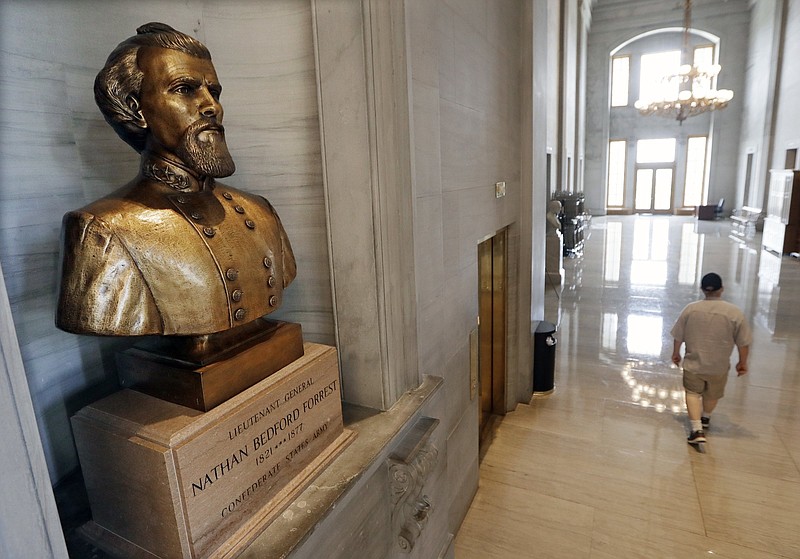Tennessee Gov. Bill Lee picked a correct - not a politically correct, but a correct - side when he called for Confederate Gen. Nathan Bedford Forrest's bust to be removed from the state's Capitol building and relocated to the state museum where it might provide "more historical context."
That would have to mean more historical context to slave trading and the early Ku Klux Klan in the Volunteer State.
"Forrest represents pain and suffering and brutal crimes committed against African Americans, and that pain is very real for our fellow Tennesseans," Lee, a Republican, told reporters during a news briefing Wednesday.
But on Thursday, when the Tennessee Capitol Commission voted 9-2 to relocate the Forrest bust, it changed the parameters a bit. The panel voted to relocate Forrest and two other military statues in the Capitol to the state museum to be part of a Tennessee military heroes exhibit. The other two busts are Admiral David Farragut, who in the Civil War was a flag officer for of the U.S. Navy serving the Union, and Navy Admiral Albert Gleaves, who had nothing to do with the Civil War (he was only 7 when the war ended).
The last-minute amendment to add the other two statues was offered by ex-officio and nonvoting commission member, Comptroller Justin Wilson, and it caused some heartburn among the members most interested in seeing the Forrest bust moved.
And well it should.
Might the change be a Trojan Horse designed to delay or even derail the move when the question goes next to the Tennessee Historical Commission? Time will tell.
The Volunteer State's already long-standing controversy over the Forrest bust was supercharged this spring after the death of George Floyd, a Black man who died in Minneapolis police custody as an officer held his knee on Floyd's neck for about eight minutes. The shameful incident, caught in its entirety on video, shocked the country and triggered racial unrest nationwide. It also ignited a renewed debate about racism in American society, and Confederate monuments have become a lightning rod of that debate.
Lee - who in January 2019 opposed the removal of Forrest's bust, then in June wouldn't take a stand on the question - noted to reporters on Wednesday that the Forrest likeness, placed outside the House and Senate chambers in 1978, "has spurred a heated debate that began long before all of this national ruckus on monuments that we're seeing play out today."
Indeed. Lee's predecessor, former Republican Gov. Bill Haslam, in September 2017 made it clear he was disappointed with the Capitol Commission's rejection of an earlier plan to relocate the Forrest bust to the state museum.
"I was very disappointed," Haslam said at the time. "I was really clear. If we are going to honor a limited number of Tennesseans in the Capitol, Forrest should not be in that list."
Be it duly noted, too, that the General Assembly could also have taken action to remove the bust back in 2017 and since. But our Republican majority lawmakers haven't seen fit to stop thumbing their noses at Tennesseans with a monument to a Confederate general known as "the Wizard of the Saddle," whose troops massacred surrendering federal soldiers, many of them Black, at Fort Pillow in West Tennessee.
Little has changed among our lawmakers. In the commission hearing Thursday, the only two people voting to keep the Forrest statue - and the other two monuments - in the Capitol were the only lawmakers on the panel: Sen. Jack Johnson of Franklin and Rep. Matthew Hill of Jonesborough.
Lee's push to remove the Nathan Bedford Forrest bust is the right thing to do. And his change of heart may be explained with another statement he made to reporters Wednesday when he said Forrest's bust is "not just another Confederate symbol. There are reasons that this particular bust, for 40 years, has stood above others and points to one of the most regretful and painful chapters of our history."
Lee's timing was interesting, too, making his announcement in advance of Thursday's meeting of the Capitol Commission, the same body that rejected Haslam's plan to move the statue. This time, however, the 12-member panel is now made up of seven Lee appointees, three of whom are Black.
Meanwhile, Lee since Monday also had withheld action on a bill passed last month by the GOP-run General Assembly to provide Republican leaders two more appointments to the Capitol Commission to block any move by the commission to remove the Forrest bust. The governor said he would not act on the bill before Thursday's State Capitol Commission meeting.
Some members of the commission Thursday talked of Forrest's religious conversion and regret toward the end of his life. We hope that's true. But a likeness of that redeemed man is not the statue that sits in a prominent alcove in the Capitol. What's there on display is the younger, Confederate general and former slave trader who, according to historian Albert Castel, acknowledged the racial motivation for the war.
"If we ain't fightin' to keep slavery, then what the hell are we fightin' for?" Forrest said, according to the writings of Castel, as quoted in The Tennessean.
Commission member Hallerin Hill, who is Black, told the panel the statue should go, and it didn't matter whether it went alone or with two other statues in the Capitol.
"We don't erase history. History is what it is," he said.
